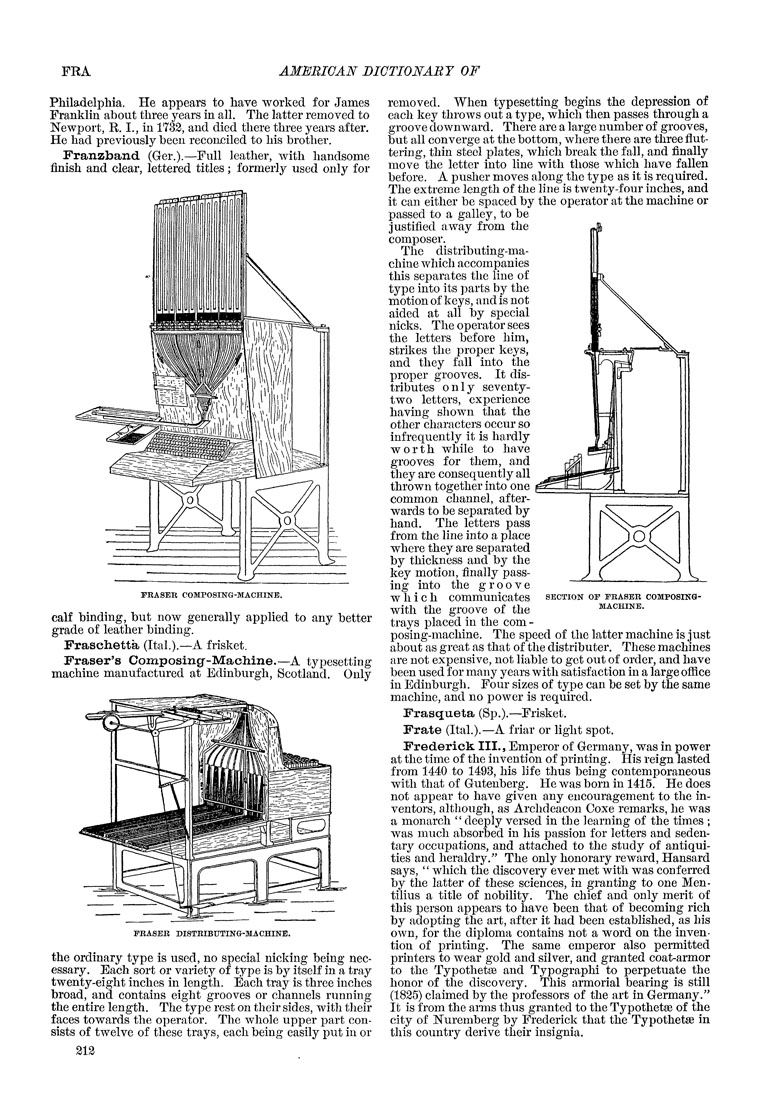FRA
AMERICAN DICTIONARY OF
Philadelphia. He appears to have worked for James
Franklin about three years in all. The latter removed to
Newport, R. L, in 1732, and died there three years after.
He had previously been recoruciled to his brother.
Franzband (Ger.).—Full leather, with handsome
finish and clear, lettered titles; formerly used only for
FRASER COMPOSING-MACHINE.
calf binding, but now generally applied to any better
grade of leather binding.
Fraschetta (Ital.).—A frisket.
Fraser's Composing-Machine.—A typesetting
machine manufactured at Edinburgh, Scotland, Only
FRASER DISTRIBUTING-MACHINE.
the ordinary type is used, no special nicking being nec¬
essary. Each sort or variety of type is by itself in a tray
twenty-eight inches in length. Each tray is three inches
broad, and contains eight grooves or channels running
the entire length. The type rest on their sides, witli their
faces towards the operator. The whole upper part con¬
sists of twelve of these trays, each being easily put in or
212
removed. When typesetting begins the depression of
each key throws out a type, which then passes through a
groove downward. There are a large number of grooves,
but all converge at the bottom, where there are three flut¬
tering, thin steel plates, which break the fall, and finally
move the letter into line with those which have fallen
before. A pusher moves along the type as it is required.
The extreme length of the line is twenty-four inches, and
it can either be spaced by the operator at the machine or
passed to a galley, to be
justified away from the
composer.
The distributing-ma¬
chine which accompanies
this separates the line of
type into its parts by the
motion of keys, and is not
aided at all by special
nicks. The operator sees
the letters before him^
strikes the proper keys,
and they fall into the
proper grooves. It dis¬
tributes only seventy-
two letters, experience
having shown that the
other characters occur so
infrequently it is hardly
worth while to have
grooves for them, and
they are consequently all
thrown together into one i
common channel, after¬
wards to be separated by
hand. The letters pass
from the line into a place
where they are separated
by thickness and by the
key motion, finally pass¬
ing into the groove
which communicates
with the groove of the
trays placed in the com -
posing-machine. The speed of the latter machine is just
about as great as that of the distributer. These machines
are not expensive, not liable to got out of order, and have
been used for many years with satisfaction in a large office
in Edinburgh. Four sizes of type can be set by the same
machine, and no power is required.
Frasqueta (Sp.).—Frisket.
Frate (Ital,).—A friar or light spot.
Frederick III., Emperor of Germany, was in power
at the time of the invention of printing. His reign lasted
from 1440 to 1493, his life thus being contemporaneous
with that of Gutenberg. He was born in 1415. He does
not appear to have given any encouragement to the in¬
ventors, although, as Archdeacon Coxe remarks, he was
a monarch "deeply versed in the learning of the times ;
was much absorbed in his passion for letters and seden¬
tary occupations, and attached to the study of antiqui¬
ties and heraldry." The only honorary reward, Hansard
says, '' which the discovery ever met with was conferred
by the latter of these sciences, in granting to one Men-
tilius a title of nobility. The chief and only merit of
this person appears to have been that of becoming rich
by adopting the art, after it had been established, as his
own, for the diploma contains not a word on the inven¬
tion of printing. The same emperor also permitted
printers to wear gold and silver, and granted coat-armor
to the Typothetse and Typographi to perpetuate the
honor of the discovery. This armorial bearing is still
(1825) claimed by the professors of the art in Germany."
It is from the arms thus granted to the Typothetse of the
city of Nuremberg by Frederick that the Typothetse in
this country derive their insignia.
SECTION OF ERASER COMPOSING-
MACHINE.
|








